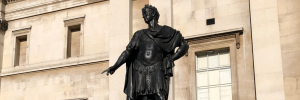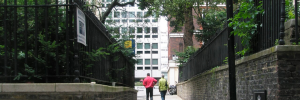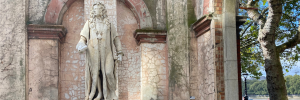The Monument was built between 1671-1677 to commemorate the Great Fire of London of 1666 which ended up destroying four-fifths of the city. It is a column standing on a very large pedestal, some 20 feet high, much of which is covered in dense Latin writing.
This goes unremarked today, partly because so few of us read Latin. Then as now only a minority of people would be able to read it, even if in the 17th century Latin was a more important language and in theory if you were a gentleman it was something you were familiar with. The texts are aimed at the educated and the powerful, and they are aiming to make a political point.
The pedestal has three sides which have writing on them, and on the fourth, which faces towards the West there is a sculpture by Caius Cibber depicting the fire. Opposite the sculpture, that is on the Eastern side, there is a list of the men who were lord mayors at the time of the construction at the Monument. They are flatteringly known as prefecti, a rather grand-sounding translation, making clear a link with Rome, established by Cibber’s sculpture which shows Charles II and James Duke of York in Roman dress.
The Northern side of the monument has a text in Latin describing the progress of the fire. And then the other side, the Southern side has a list of all of the things that Charles, and to a lesser extent, his brother James have done to rebuild London.
This list claims that they transformed the old city of wood into one built of stone, with new broad streets designed on a geometrical and pleasing basis. This is an exaggeration of what they actually achieved, but it contained sufficient truth to make a plausible allusion to the emperor Augustus.
Augustus produced a long list of his achievements known as the Res Gestae Divi Augusti (The Things Done by the Divine Augustus). This was a huge piece of epigraphy that was ordered to be set up in all the big cities of the empire.
There was one version of it, for example, on Augustsus’s mausoleum. One large part of his achievements, which takes up a considerable amount of text, concerns his rebuilding of Rome. One of the claims made by Augustus is that he found Rome a city built in brick, and when he finished with it, it was a city of marble.
The Monument thus draws a parallel between Charles II and Augustus because Charles is rebuilding London in the way that Augustus rebuilt Rome. Charles is being associated with a great figure from Roman history, but it is also important because Augustus is the first of the emperors who claimed that he brought peace to Rome after a long civil war.
This is a very close, convenient parallel for Charles. He was restored to the throne in 1660 after a period of civil war, and after a republic. He is advertising the benefits of his rule by saying that he, like Augustus has, has brought peace after a period of turmoil. He is also saying that as with Rome under Augustus it is worth his subjects giving up many of the restrictions on the powers of a prince that many still wanted in order to have peace and stability.
If you want to find out more about the Monument, listen our London History Podcast Episode 8: The Monument to the Great Fire of London.
–
You can also join Ian McDiarmid, Qualified City of London Tour Guide, who delivers Great Fire of London Walk and private tour. View all of Ian’s walking tours.



